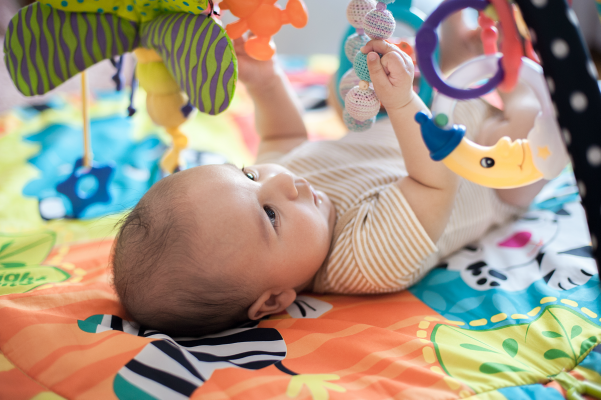
In order for your baby to roll over, they need to have a strong upper body, good control of their head and neck, and the ability to coordinate arm and leg movements. Most babies learn to roll from front to back first because it requires less strength and coordination than rolling from their back to their front, which is a more difficult milestone. You can expect your baby to roll over as early as two to three months of age. At five to six months old, they can roll from back to front.
Tummy Time and Rolling Over

Because rolling over requires a lot of upper body strength, it’s important that your baby gets daily tummy time to help them develop strong muscles and good control of their neck. Babies who don’t get a lot of tummy time may take longer than others to start rolling over. Try to place your baby on their tummy when they’re awake and alert. This will encourage rolling over and other developmental milestones. Tummy time should always be supervised.
Safety Concerns and Rolling Over
The amazing thing about your baby’s developmental milestones is that they usually don’t happen when you’re expecting them. One day, your baby will barely be able to lift his head off the ground and the next he will be rolling over. This is why most parents have at least one incident where their baby rolls off the bed or sofa. You didn’t expect that they would have the strength or ability! To prevent any injury to your child, always keep one hand free when you’re changing your baby’s diaper to prevent them from falling off the changing table. You can also use the safety strap to secure them. Likewise, you should not leave your baby on a bed or couch unattended even if they’re sleeping. Babies often surprise their parents with new tricks like rolling off the bed when their mom and dad least expect it.
Tips for Helping Your Baby Learn to Roll Over
There are a lot of things you can do as a parent to encourage your baby to roll over. The first step to take is to place your baby on their tummy several times a day. This can be on the floor over a padded area or on the couch or bed. Just make sure you do not leave your baby unsupervised during this time.
While they’re on their tummy, encourage your baby to reach for toys and look around. To get their attention, dangle rattles, soft toys, or anything your baby is attracted to over or around their head. Sometimes when baby starts to grab for things, they will reach so far that they just roll over. However, just lifting their head up to look around helps strengthen the muscles and prepares them for rolling over.
You can also use a Boppy pillow during tummy time. When your baby is first getting started with being positioned on their stomach, they may not have a lot of upper body strength. You can use this u-shaped pillow to help support their upper body during tummy time. Once they get a little stronger, they can do tummy time without the Boppy pillow and you can use it for other developmental activities, such as helping them to sit up on their own.
Another way you can help you baby learn to roll over is by physically rolling them over yourself. Gently grab their hands and body and roll them over. This will assist your baby in getting used to the movement while showing them what their body is capable of doing. Just be gentle with this activity, and it will benefit them.
When Should I Start to Worry about My Baby Not Rolling Over?

Most babies can roll over by the time they are six months old. If your baby is not rolling over at least from front to back by this time, you should discuss it with your pediatrician. If your baby is reaching other developmental milestones and is finding other ways to get around like scooting or crawling, rolling over may be nothing to worry about. Children don’t always reach milestones in the same order. Some babies, for example, will skip the crawling stage and go right to walking. Moreover, sometimes babies who weigh more than average will have challenges with the early milestones. They’ll do fine with the later milestones once they slim down. It’s fairly common for a bigger baby to take a little longer to lift up their head, roll over, or sit up. Usually, all it takes is a little activity and these plump little babies start slimming down and reaching milestones at the same pace as others. However, trust your parental instincts and never hesitate to discuss any concerns or potential red flags with your baby’s doctor.
